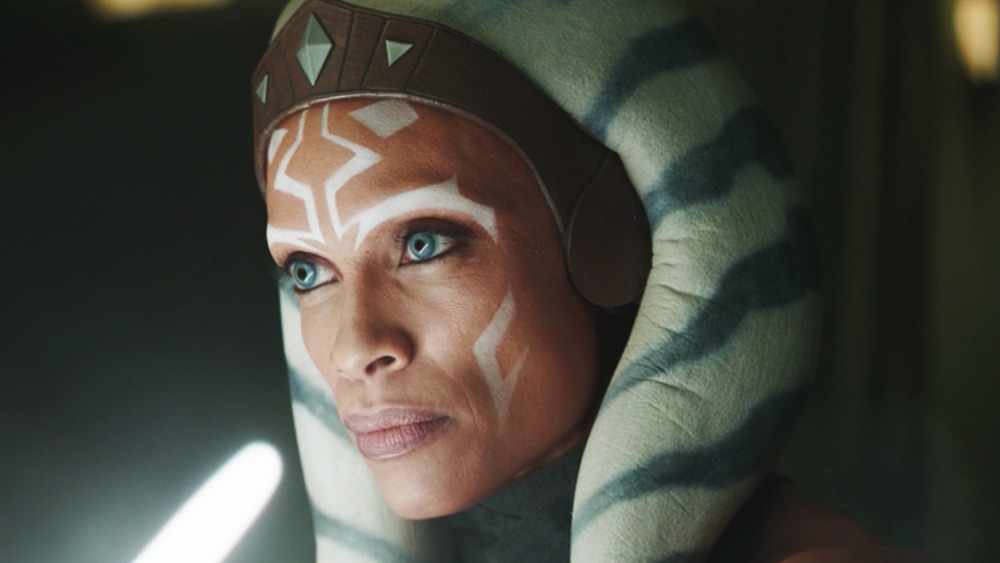Ahsoka Tano's White Lightsabers Explained
After Bo-Katan Kryze (Katee Sackhoff) teased her impending appearance during a conversation with Mando (Pedro Pascal) at the end of "Chapter 12: The Heiress," The Mandalorian finally introduced Ahsoka Tano in the fifth episode of the season, "Chapter 13: The Jedi."
Rosario Dawson brought the character to life in the episode, adding yet another layer of coolness to the experience of watching the beloved Ahsoka make the jump from animated to live-action format. Indeed, having Ahsoka join the live-action side of the Star Wars universe was every bit as amazing as fans hoped it would be, with the former Jedi Padawan revealing to Mando the truth about Baby Yoda (aka the Child) and the pair storming the city of Calodan on Corvus. One of the most intriguing elements of Ahsoka's appearance in The Mandalorian — of which there are many — comes about during her standoff with the Imperial Magistrate Morgan Elsbeth (Diana Lee Inosanto), who offered Mando a beskar spear in exchange for killing Ahsoka. As the two prepare to duke it out, Ahsoka brandishes two white lightsabers.
Seeing a white lightsaber anywhere in the Star Wars galaxy is unique and would certainly raise some questions, but having a pair of them pop up in The Mandalorian has sparked up a lot of conversation amongst the series' fans. Let's take a dive into Star Wars lore and Ahsoka's backstory to break down what her white sabers really mean.
Why Ahsoka Tano's lightsabers are white
When she was first introduced in Star Wars: The Clone Wars after making her debut in the 2008 film Clone Wars, the former Jedi had green lightsabers, but she's been on a significant journey since then. Ahsoka began as the apprentice of Anakin Skywalker, the powerful Jedi Knight whose story we all know turns grim when he betrays everything he once stood for to become the insidious Darth Vader. There's a lot that happens between the two as Anakin grows increasingly dark, and by The Clone Wars season 5, Ahsoka winds up framed for a deadly explosion at the Jedi Temple, causing her to leave the Jedi Order (though she's later exonerated). At the end of The Clone Wars, Vader picks up Ahsoka's saber amongst the remains of the crashed Star Destroyer and lights it up — walking away, believing that Ahsoka is dead.
Of course, she's still alive, and when Ahsoka appears in Star Wars Rebels, she wields different sabers — the same white ones seen in The Mandalorian. Ahsoka is unique in the Star Wars universe because she no longer identifies as a Jedi, but she also hasn't turned to the dark side. Her lightsabers are a visual representation of her decision to part ways with the Order and forge her own path. As The Clone Wars executive producer Dave Filoni, who also directed the Mandalorian episode in which Ahsoka made her live-action debut, previously explained, Ahsoka's white lightsabers are meant to show that she is neither a Jedi nor a Sith.
While there's a clear element of metaphor at play with Ahsoka's lightsabers, there's also a definitive reason that her twin weapons are white. In E.K. Johnston's 2016 novel Ahsoka, the author fills in the gap between The Clone Wars and Rebels. Prior to reappearing in Rebels, Ahsoka defeats an Inquisitor and takes his lightsaber crystals. Because he was a Sith, his crystals were corrupted, but Ahsoka heals them and realigns them with the Force. This turns them white – a symbol not only of their restored purity, but also of Ahsoka leaving the Order behind to fight for good in her own way.
Ahsoka Tano's white lightsabers are a reminder of the character's pivotal role in the Star Wars universe
While The Mandalorian marked her first live-action appearance in the franchise, Ahsoka has been hugely influential in the world of Star Wars for years now. Not only is she the first major female Jedi, but she's also a gateway character for young women looking for a hero they could relate to. (Remember, she predates Daisy Ridley's Rey, the central hero of the Star Wars sequel trilogy, by more than a decade.) Ultimately, Ahsoka has become a fan-favorite character whose decision to turn her back on the Order — but not on fighting against evil — makes her a trailblazer within the world of the franchise.
In an April 2020 interview with Vanity Fair, Dave Filoni explained the significance of Ahsoka's choice to separate from the Order.
"She's not a Jedi. Not because she couldn't be, but because she chose a different path," he said. "Ahsoka choosing to leave the Jedi Order was one of the most powerful moments of The Clone Wars series, and I think is one of the most important stories in all of Star Wars. She left the Order, but she didn't stop helping people. She went her own way and helped take down the Empire. So I wouldn't call her a Jedi or a padawan. She's a hero."
All in all, Ahsoka's white lightsabers serve as a clear reminder of both her choice and her continued devotion to fighting against the dark side.


